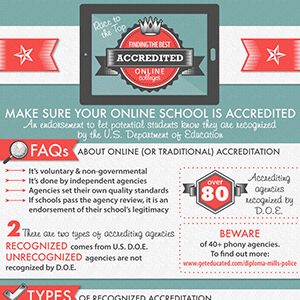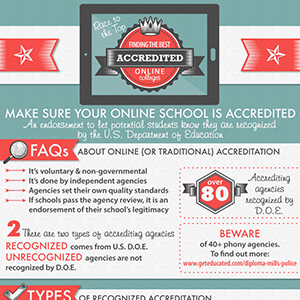FAQs about online (or traditional) accreditation:
It’s voluntary and a non-governmental
It’s done by independent agencies
Agencies set their own quality standards
If schools pass the agency review, it is an endorsement of their school’s legitimacy
Over 80: Number of accrediting agencies recognized by D.O.E.
2: There are two types of accrediting agencies
Recognized: comes from U.S. D.O.E.
Unrecognized: agencies not officially recognized by D.O.E.+
Fact: BEWARE of 40+ phony agencies.
Types of “Recognized” Accreditation
“Institutional” and “programmatic.”
Institutional accreditation normally applies to an entire institution,.
Specialized or programmatic accreditation applies to programs, departments, or schools that are parts of an institution.
FACT: D.O.E. does not accredit colleges in foreign countries. It does appoint members to the National Committee on Foreign Medical Education and Accreditation.
Functions of Accreditation
Verifying that an institution meets established standards;
Assisting prospective students in identifying acceptable institutions;
Assisting institutions in determining the acceptability of transfer credits;
Helping to identify institutions and programs for the investment of public and private funds;
Protecting an institution against harmful internal and external pressure;
Creating goals for self-improvement of weaker programs
Involving the faculty and staff comprehensively in institutional evaluation and planning;
Establishing criteria for professional certification and licensure
Providing one of several considerations used for determining eligibility for Federal assistance.
The Accrediting Procedure
The agency sets the standards.
The institution prepares an in-depth self-evaluation study that measures its performance against agency standards.
On-site Evaluation: A team selected by the accrediting agency visits the institution.
Publication: Upon being satisfied that the applicant meets its standards, accrediting agency lists the institution or program in an official publication with other similarly accredited or pre-accredited institutions or programs.
Monitoring: The accrediting agency monitors each accredited institution or program.
Reevaluation: Accrediting agency periodically reevaluates each institution
1996: Year Jones International University was accredited, thus becoming the first fully online university accredited by a regional accrediting association in the US.
Trendlines: Accredited online education is growing at a whirlwind pace:
1,865: Estimated (because the number is growing) number of top accredited online universities
307,965: Estimated number of students enrolled in 2013 in U. of Phoenix Online College, making it the largest enrollment of any school, online or not in the U.S.
14 million: number of students that will enroll in an online course in 2014
2 %: overall rise in higher education enrollment
10%: rise in online enrollment
Number of students enrolled in at least one online college course
2002: 1.6 million
2005: 3.2 million
2010: 6
By 2013: estimated more than 6 million.
That’s 1/3 of all college students.
Student satisfaction, online education vs. traditional
51 %: say it’s about the same
27.7 %: somewhat inferior
13.9 %: somewhat superior
9.7 % inferior
2.7 %: superior
Still:
10X: The rate of growth in online enrollments is ten times that of the rate in all higher education
65: percentage of higher education institutions saying that online learning is a critical part of their long-term strategy.
77: percentage of academic leaders rate the learning outcomes in online education as the same or superior to those in face-to-face.
FACT: Among faculty, cost (88% reporting as important or very important) and ease of use (86%) are most important for selecting online resources.
Best online programs
Bachelor’s Degree Programs (in general, overall)
Pace University, New York City, $556 a credit
Daytona State College, Daytona Beach, Fla., $121 a credit, in-state student; $634 out of state
Graduate education
St. Johns U., Queens, N.Y, $1,050 a credit
Auburn U., Auburn, Ala., $437 a credit
Graduate information technology
University of Southern California, Los Angeles, Ca., $1,569 a credit
Sam Houston State U., Huntsville, Tx, $237 a credit
Graduate engineering
U. of Southern California, Los Angeles, Ca., $1,569 a credit
Penn State World Campus, credit price not available
Graduate nursing
Ferris State University, Big Rapids, Michigan, $485 a credit, in state students; $728 out of state
Lamar U., Beaumont, Tx., $900 in state tuition per credit; $451 for out of state
Sources:
https://www.petersons.com/
https://www2.ed.gov/admins/
https://www.
https://nces.ed.gov/fastfacts/
https://www.
http://sloanconsortium.org/
https://www.usnews.com/


